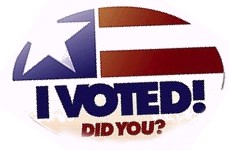
I voted. There were no problems. During the primary elections a few months ago, Montgomery County in Maryland experienced a small disaster with electronic voting machines, primarily because election workers were not adequately trained in how to operate teh devices and election cards were not distributed to the polls. That did not happen today. But there were two moments that caused me to wonder about the security of the voting process.
First, when I approached the desk to receive a voting card, I was asked my name, address and date of birth. The women on the other side did not request any identification--nothing with or without a photo. Anyone who cared to impersonate me--and who knew my address and birthday--could have done so. This was unsettling. After all, when I retrieve packages from the Post Office, I have to show identification. I realize that conservatives have long complained that no-ID voting creates the opportunity for voter fraud. That's undeniable, though it would take an extensive and well-coordinated campaign to engage in fraud-by-impersonation on a significant scale. And Democrats have a point when they contend that voting should be as easy as possible. Nevertheless, it's tough to argue that citizens should not have to show any form of identification to gain access to the ballot box.
Second, after selecting my choices on an electronic touch-screen machine, I pressed the "Cast Ballot" button on the screen, and I received a message: Your vote has been cast. It probably was. But how could I know for sure? I received no receipt. All that happened was some digitalized 1s and 0s were shuffled around inside the machine and zapped to another machine, courtesy of proprietary software not open to public inspection. I have not concluded--as have others--that electronic voting machines are routinely rigged (by Republicans) to change results. But I have for years believed that since they can be rigged--and the evidence is compelling on this front--people are right to fret about the integrity of the voting system.
Sure, all systems are vulnerable to underhanded chicanery. Old-fashioned ballot boxes can be stuffed. But the goal should be to minimize the ability of any would-be tamperers to engage in dirty-trickery that can affect a decisive number of votes, and electronic voting does not pass this test--not yet. When we used to write X's on paper ballots or pull levers on voting machines, voters still had to have faith that all the votes would be counted honestly. Given that it would take a concerted effort of a number of people to falsify the results with those vote-counting methods, it was not hard to have a decent level of confidence in the voting process in most localities. But when we press a finger against the "Cast Ballot" image on a screen, we require a higher degree of faith that the counting system is working as it should and that it has not been tainted by a tiny group of persons. Presumably, a modest programming alteration in some cases could lead to phony results. As I walked away from the machine, I worried about my vote--more than a citizen should have to.
Posted by David Corn at November 7, 2006 11:47 AM